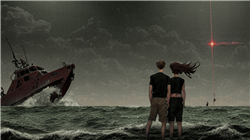A.I.’s Chances of Winning an Annie Suddenly Got Much Better after ‘Red Skies’

When Deep Blue, a computer, beat world chess champion Garry Kasparov in 1997 some journalists found comfort in the thought that A.I. would never be able to write like Shakespeare.
Well, think again. Or, better, check out the title sequence of Series Mania live action entry “Red Skies.”
Shared with Variety, it is being hailed by the series’ makers, including designer Merav Shaham, as the first ever title sequence made solely with Artificial Intelligence.
What’s so impressive – and perhaps even preoccupying for those who fear A.I. – is that the sequence is, more than technically brilliant or absolutely incoherent, highly touching in human terms and unexpectedly and sometime mysteriously poetic – the last qualities you might expect from A.I.
This is a major series as well, playing Series Mania main competition, backed in a just-announced deal by Len Blavatnik and Danny Cohen’s Access Entertainment, and counting among its creators on Ron Leshem, (“Euphoria”), Amit Cohen (“False Flag”) and Alon Zingman (“Shtisel”). It’s not at all a series where, in its crucial first few minutes you’ll use any old credit sequence in the name of forward-facing technical experimentation. “I was a bit nervous letting a machine do the opening for something I’d been working on for 20 years,” says series co-creator Daniel Shinar, whose book the series adapts. “Then, when we saw the results the first time, people were crying. It’s a beautiful, sensitive video, very unique.”
How does the sequence play out?
Animation, 70 seconds in length, it echoes the hugely impressive collage of scenes already seen in other title sequences by designer Merav Shaham – “Fauda,” Season 3, “Valley of Tears” – which, though sometimes fast in delivery, builds through micro-narrative to a final sense born out by the series in question.
In practical terms, Shaham, Leshem and Zingman brainstormed what situations they would like to test through a software, Stable Diffusion, writing a script especially adapted for this type of work.
Released in 2022, Stable Diffusion provides a video version of the better-known A.I. platform ChatGPT, being a deep learning text-to-image model primarily used to generate detailed images conditioned by text descriptions.
“The great challenge was to develop a clear narrative around events that happened in reality: the series evolves against the events of the Second Intifada in Israel in the early 2000s,” Shaham says.
A character-driven war action drama series, if the two episodes which world premiered Saturday at Series Mania in Lille are anything to go by, “Red Skies” turns on two inseparable friends, both in love with the same girl, Jennie, but torn apart as Palestinian Ali is forced to join the Palestinian Militia and Israeli Sa’ar a secret Israeli intelligence unit. Jennie, from America, becomes a war photographer. “If you told me what we became, I wouldn’t have believed you. Ever,” Ali says in a voiceover early in Episode One.

The title sequence picks up on the same theme in animation which ranges between photo-realistic shots highlighting figures, such as a young boy weeping holding his face in his hands, to a broad naturalism to manga details – two missiles lifting off in the sky – to a more stylized surrealism in character design and background.
Lending a strong poetic undertow to events, the natural becomes unnatural, and scenes of potential happiness are countered by a context of war.
The title sequence begins, for example, with a teen girl and boy bathing in a sea. Beyond them, however, planes bomb the horizon, the sky rendered a sullen grey by explosions and dust. Two young folk singers strumming guitars become soldiers in combat garb, yielding semi automatics. A woman films a quiet quaint suburb which is reduced to rubble; a mother pushes a pram across a road along which just seconds later tanks advance towards the viewer.
“Most of the products we know today in A.I. have a very psychedelic and disturbing aesthetic, often surreal and incoherent,” says Shaham.
She worked hard, she says, to establish results closest to her written scenario. “This task was not easy at all, There was a lot of trial and error in this kind of work. A large part of the materials is thrown away and there is a lot of curating and editing work to do,” she said.
Presenting a further challenge, “this tool is constantly evolving and while working, the A.I. models were replaced and changed and with them there were radical changes in quality and style. So I had to adapt quickly to these changes on a daily basis.”
Yet the results were worth the effort, Shaham argues. “Although the animation came out of a non-human machine, the personal touch and sensitivity stood before my eyes more than ever precisely for this reason.”
“You just have to give the A.I. a few lines about what the story is about and the machine starts imagining a sequence,” says Leshem.
It was A.I. which suggested the use of guitar music, though not the song. The title sequence unspools to the fragile strains of Israeli band Theangelcy’s “Giant Heart,” a love song sung with just a guitar as accompaniment: “Oh my darling babe, take me in your arms, don’t let me be a stranger…”
“Red Skies” title sequence builds to a scene of a girl and a boy, joined by a third young figure, standing again in the sea, as a ship – warship, trawler, patrol ship, its identity changing multiple times – plows towards them, sinking.
“Red Skies” the series is a very emotional story, a love story which asks if there’s any way to escape, for that love to survive, when an entire city, an entire region is on flame,” Leshem said, interviewed by Variety.
The title sequence anticipates this question, portraying scenes whose figures seem threatened by an ever-present, all engulfing war which changes everything and everyone.

Read More About:
Source: Read Full Article